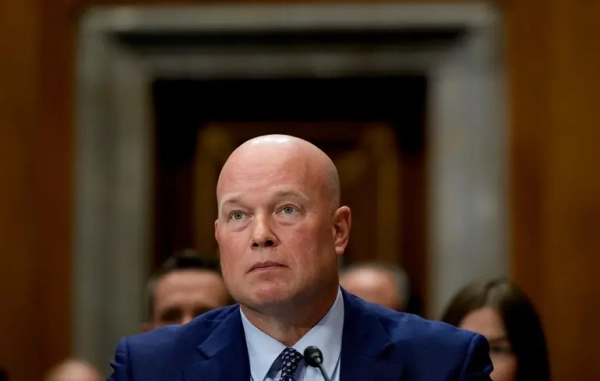America rarely has its financial ducks in a row. Does it finally matter?

The government might be in a smidge of a pickle with deficits and debt. PM Images via Getty Images Emily Stewart covers business and economics for Vox and writes the newsletter The Big Squeeze, examining the ways ordinary people are being squeezed under capitalism. Before joining Vox, she worked for TheStreet.
As though there were not enough things in the world to worry about at the moment, a perennial issue has once again been percolating: Is the United States’ financial house in order? Talk about the federal government’s deficit — meaning the difference between what it spends and what it collects in taxes — has started to pick back up. The same goes for chatter about the country’s debt. Deficits are a gamble — a wager that the government paying out more than it’s taking in, especially as time goes on, is worth the risk. Not everyone thinks it’s such a good bet.
Some prominent economists who were once pretty laid back on the matter have started to change their tune. Not everyone is setting their hair on fire, but it has been a bit of a “Wait, what?” moment in terms of deciphering just how much to worry, or whether to worry at all.
The federal deficit officially clocked in at $1.7 trillion in fiscal year 2023 (the government’s fiscal year runs from October 1 to September 30), up from almost $1.4 trillion in 2022. Thanks to some wonkiness around the Supreme Court-thwarted attempt to cancel student loan debt, it was actually likely closer to $2 trillion for 2023 and $1 trillion for 2022. In other words, the gap between what the government spends and what it makes is a big one — and about doubled from one year to the next.
There are some 2023-specific reasons that the deficit was particularly high; namely, the government saw a big dip in tax revenue. However, there are plenty of trends that aren’t limited to this specific year.
What’s further spooked onlookers are higher interest rates, which have made the country’s debt more expensive because of higher interest costs. Interest rates on US Treasury bonds started to climb over the summer and into the fall, and while they have come down from some of the highs they were at in October, they remain elevated overall, making people a little more nervous.
“You know the meme that’s like mess around and find out? That’s a little what happened here,” said Marc Goldwein, senior vice president and senior policy director for the Committee for a Responsible Federal Budget, a think tank focused on fiscal responsibility. Years of low interest rates, low inflation, and strong global savings, among other factors, made deficits palatable and easy to ignore in practice on both the right and the left (except when politically convenient). Now, the landscape has shifted.
Lawmakers have made the bet that deficits are worth the trade-off and the debt is manageable, and these soaring rates and their attendant anxiety show just how high the stakes of that gamble are. That risk also calls attention to how difficult the issue is, politically. While many experts say there’s next to no chance of balancing the budget, getting revenue and spending back in line would require compromises few people on Capitol Hill are willing to make. Republicans don’t want to raise taxes and keep cutting them instead, seemingly worrying about deficits largely only when they’re not in office. Democrats don’t want to curb spending, and raising taxes isn’t easy. It’s not clear what, if anything, would make anyone budge.
“I don’t think you’re going to get a solution to this [deficit] until it really is something quite salient to the public, to politicians, and the thing that I’ve been saying for years is … that will happen when markets start to care, when interest rates start to rise,” said Louise Sheiner, a senior fellow at the Brookings Institution and policy director of the Hutchins Center on Fiscal and Monetary Policy. Despite high interest rates, she’s still not sure if this will prove to matter now. “This may be just this little head-fake where interest rates went up and then they came back down and it was no big deal, or we may turn around and may look back at this moment in 10 years and say, ‘That was the moment when people did start to worry about the deficit again and we started doing stuff.’ I don’t know which one it will be.”
2023 is unique, and it isn’t
The 2023 deficit wasn’t necessarily outlandishly high. The deficit also topped $1 trillion in the years following the Great Recession. It was over $3 trillion in 2020 and more than $2 trillion in 2021 because of the pandemic and related spending under Presidents Donald Trump and Joe Biden. “You had Donald Trump go on a huge tax cut and spending spree, and then Joe Biden went on a spending spree,” said Brian Riedl, senior fellow at the Manhattan Institute.
But the deficit being so high in a relatively normal period in 2023 — no recession, no war the US is fighting — is a bit different. What exactly were we spending money on, and why didn’t we have the funds to cover it?
The main culprit this year is taxes (spending was only slightly higher than where it was in 2022). As Jim Tankersley at the New York Times explains, the government brought in an especially low amount of revenue. The IRS extended tax-filing deadlines for people because of natural disasters, including for most people in California, the country’s most populous state. A lot of firms took advantage of a pandemic-era tax credit for retaining workers — some of those claims may be fraud. Capital gains taxes, which come when an asset, like a stock, is sold, also fell from 2022, when they were abnormally high. The decline in capital gains taxes is an effect of high interest rates from the Federal Reserve, which contributed to stock market declines and a downturn in companies going public. (This is a big issue in California’s budget.)
“The trajectory of debt has not fundamentally shifted in the last few years”
“The 2023 deficit was certainly anomalous, and I think people are using a ‘that’s weird’ as a point of proof, but I don’t think it actually has much to do with genuine concern over fiscal risk,” said Michael Linden, senior policy fellow at the Washington Center for Equitable Growth. “The trajectory of debt has not fundamentally shifted in the last few years.”
Still, the trajectory is one that some people find to be uncomfortable.
Tax revenue as a percentage of GDP was abnormally high in 2022 and in 2023, it reverted closer to what it was pre-pandemic. Tax cuts, including those put in place by George W. Bush (and made permanent under Barack Obama) and Donald Trump, are taking a bite out of revenue and will continue to do so. The Trump tax cuts are set to expire in 2025, and it’s not clear whether they might be extended.
At the same time, government spending is on track to continue growing. As baby boomers age, programs like Social Security and Medicare are getting costlier. Defense is always an expensive line item, and there’s demand for more in order to help Israel and Ukraine. And there’s the question of interest costs, too.
“People have changed their views because the aging population is starting to hit — the pre-programmed rise in Social Security and Medicare is happening, and people are looking at it in 10-year projections where it wasn’t before, because baby boomers are retiring. The second issue is interest costs,” said Danny Yagan, an economics professor at the University of California, Berkeley. “The truth is that the interest costs are a much smaller deal now than people think they are, because economic growth has edged out interest rates for years and is generally projected to for some time.”
How big of a deal this is isn’t really clear
America’s debt and the potential implications of high deficits were pretty easy to ignore in the lower interest rate environment the country has been in for the last several years. As borrowing costs rise, paying interest on America’s debt load becomes pricier, especially if those higher costs persist.
“The debt used to appear costless, because the interest rates were, in many cases, below inflation and almost always, for the last 15 years, below economic growth,” Goldwein said. The debt issued when borrowing that was more or less free is now being rolled over, meaning renewed, at higher interest rates, he said. The Center for a Responsible Federal Budget notes that more than half of the country’s debt matures over the next three years.
There are a number of factors potentially playing into interest rate increases on Treasury bonds in the financial markets, but there’s no one single factor to pinpoint. The Federal Reserve has hiked interest rates to fight inflation and is expected to perhaps keep them there for a while. The New York Times points out strong growth, fewer buyers of American debt from abroad, and overall worries about debt sustainability as contributing factors. Sheiner, from the Brookings Institution, said brinkmanship over the debt ceiling, threats of a government shutdown, the overall political environment, and a downgrade on US credit could be part of it as well. “Markets aren’t always 100 percent rational, and you can’t predict every day why it’s doing stuff,” Sheiner said.
“Why did we see a spike of interest rates on federal debt over the last six months, and why is it coming down now? I don’t think it’s obvious what the right answer is,” Linden said.
If the economy grows faster than interest rates, the general line is that running a deficit is more or less okay, because the debt-to-GDP ratio, an indicator of the country’s ability to pay back its debts, doesn’t increase. The problem would come if interest rates outpace economic growth.
Many economists and experts say it’s not time to panic — interest rates have come back down. “Growth is definitely still higher than interest rates, but it’s closer than it was in the past,” Linden said. “If the 10-year Treasuries were sustained at 5, 6, 7 percent for more than six months or something like that, I would start to be like, ‘Okay, is there something really going on here?’ Especially if that happened at the same time as a Fed cut.”
“All else being equal, lower debt is better, but all else is never equal”
Bobby Kogan, senior director of federal budget policy at the Center for American Progress, a progressive think tank, emphasized that it’s also important to take a look at what a high deficit is paying for. Kogan — who is in the camp that believes the Bush and Trump tax cuts are largely responsible for the issues of today — pointed out that the spending side of the equation is one that is popular. Most people don’t want cuts to Social Security and Medicare. “All else being equal, lower debt is better, but all else is never equal,” he said. “All else being equal, we probably would want lower debt, but if you gave me an option between the current path and eviscerating the social safety net, that’s a different question.”
When it comes down to it, the political will to fix this is roughly zero
The country isn’t necessarily careening toward financial ruin because of its deficits and debt. To quote Kogan, “our current level of debt is manageable because we’re managing it.” But it’s something that probably has to be addressed eventually.
The worst-case scenario here would be something like a debt spiral, where higher interest rates and a growing debt mean the costs of servicing the debt get higher and higher, eventually spinning out of control and pushing deficits up more and more. But the worst-case scenario isn’t the only undesirable one. There could be other consequences around slowing economic growth or “crowding out” investment, meaning the government’s needs on borrowing and spending impact borrowing and investing in the private sector. “You don’t need a crisis for debt to be bad,” Goldwein said.
“Neither party is remotely serious about either spending cuts or tax increases”
Given the landscape, one might find themselves asking why the government doesn’t take a look at the deficit before it gets out of hand. That’s where there’s an awkward standoff. The GOP generally wants to cut taxes, and certainly not raise them, and would rather cut spending instead. Democrats do not want to cut spending, especially on vital programs such as Social Security and Medicare. Many Democrats would be into raising taxes, especially on corporations and the wealthy. They haven’t had the numbers to do so in a big enough way, though the Biden administration has implemented some tax changes on corporate minimum tax and stock buyback tax, and is pushing for more funding for the IRS to collect more of what’s owed.
“Neither party is remotely serious about either spending cuts or tax increases,” Reidl said. “The momentum has shifted that people are at least talking about the deficit and they’re not proposing a big expansion, but they’re nowhere close to actually solving the deficit.”
“Not only do you not have to balance the budget, but it’s not clear that you could,” Goldwein said. Even if there were a “staunch Paul Ryan-type figure,” referring to the former budget hawk Speaker of the House, who was looking to go after spending, it’s unlikely the issue could be addressed without looking at revenue, he added. “The bottom line is either the middle class is going to have to contribute … on the tax side or on the spending side,” he said. “There really is no path if they’re not part of it and realistically even that, I think, would be very hard.”
The runway isn’t endless. The Social Security trust fund is expected to run out of money in about a decade, which means taxes or benefits would need to be cut or the government would have to find money somewhere else.
Republicans often claim that they’re serious about addressing the deficit. This year, some hardline members of the House GOP have been fighting for spending cuts, proclaiming concerns for the budget. But when in power, the GOP has slashed taxes. Efforts even now seem insincere — many Republicans are also pushing to take funding away from the IRS, which would lower revenue, not increase it.
Democrats have taken a more complex approach to deficits. There’s an argument to be made that during the Obama years, Democrats were too worried about them. That resulted in a reluctance to spend and ultimately dampened the recovery from the Great Recession.
Part of what’s disturbing about the situation is that nobody really knows the answer to what level of deficit is truly sustainable, what level of debt would be completely destabilizing, and if or when that day will arrive. Nobody can really predict the future here.
“We will have to do something eventually. What does that mean? Nobody really knows what [that] eventually means, the longer you wait, the more you are shifting costs onto the future generation,” Sheiner said. “It’s always about intergenerational equity.”
Sourse: vox.com






